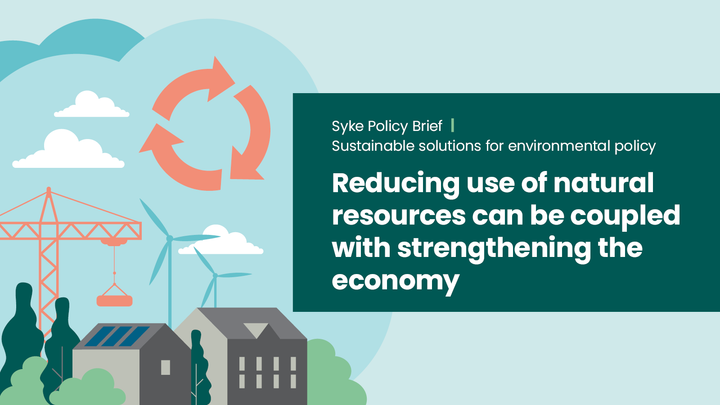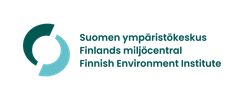Policy Brief: Reducing use of natural resources can be coupled with strengthening the economy
The Finnish economy can grow even if the raw material consumption is reduced. At the same time, climate change and biodiversity loss will be mitigated, and pollution reduced. Finland should transition to a circular economy, as it reduces the use of natural resources and promotes crisis resilience. The new Policy Brief published by the Finnish Environment Institute explains how decoupling raw material consumption and economic growth is possible and what the transition to a carbon-neutral circular economy society requires.

Biodiversity loss, climate change and pollution are largely due to the use of virgin natural resources. By reducing the extraction of virgin natural resources and paying more attention to nature, biodiversity loss will be curbed.
"The transition to a carbon-neutral circular economy enables sustainable and efficient use of natural resources while solving climate and environmental challenges and opening up new economic opportunities for Finland," emphasises Professor Jyri Seppälä from the Finnish Environment Institute (Syke).
Economic growth can be decoupled from resource consumption and environmental impacts
There is a great need for the transition to a circular economy, as Finland's raw material consumption per capita is more than three times higher than the EU average, and the added value of natural resource use is among the lowest in the EU.
The objective of Finland's Circular Economy Programme is to transition to a carbon-neutral circular economy society, where the raw material consumption growth will halt by 2035.
"The transition is feasible without weakening the economy. At the same time, greenhouse gas emissions and air pollution can be reduced, and biodiversity loss can be slowed down. However, decoupling economic growth from the consumption of natural resources and environmental impacts requires that circular economy and low-carbon measures are widely adopted in different sectors of society, such as construction, industry, consumption, energy sector and food system," highlights Senior Research Scientist Hannu Savolainen from Syke.
Key circular economy measures in the transition include more efficient use of materials, increased supply and use of recycled materials, increased added value in industry, and consumption focusing on long-lasting products and services instead of goods.
There are ways for sustainable use of natural resources
The transition to a carbon-neutral circular economy society requires more ambition and effective regulation from Finland. This will strengthen Finland's role as an internationally competitive and sustainable circular economy operator.
"Circular economy is promoted through regulation that maintains and creates markets for sustainable circular materials, products and services. Finland should support EU's circular economy initiatives, such as the Ecodesign regulation promoting the extension of the lifespan and recyclability of products, and the proposal to verify green claims," emphasises Enni Ruokamo, Senior Research Scientist at Syke.
Investments in industries that are resource-efficient and add high value, and clean energy are essential for the transition to a carbon-neutral circular economy. In addition, policies that reduce land use pressures and strengthen carbon sinks should be increased.
Syke Policy Brief:Reducing use of natural resources can be coupled with strengthening the economy (helsinki.fi)
More info:
Senior Research Scientist, Group Manager Hannu Savolainen, Finnish Environment Institute, tel. 029 525 1839, firstname.lastname@syke.fi
Senior Research Scientist Enni Ruokamo, Finnish Environment Institute, tel. +358 295 252 092 firstname.lastname@syke.fi (available from 7.5.)
Professor, Director Jyri Seppälä, Finnish Environment Institute, tel. +358 295 251 629, firstname.lastname@syke.fi
Check out Syke Policy Briefs: syke.fi/policybriefs/en
Keywords
Contacts
Media service at Finnish Environment Institute
Our Media Service provides information on research, helps journalists find experts for interviews and provides photos for media use.
Our Communication experts will answer your inquiries on weekdays from 9 am to 4 pm.
Finnish Environment Institute - We build hope through research.
Finnish Environment Institute
Latokartanonkaari 11
00790 Helsinki
+358 295 251 000
It is time to move beyond solving environmental problems one by one, to systemic sustainability transformations. The Finnish Environment Institute (Syke) contributes to building a sustainable society through research, information and services. The Finnish Environment Institute is a research institute with 700 experts and researchers located in Helsinki, Oulu, Jyväskylä and Joensuu.

Subscribe to releases from Suomen ympäristökeskus
Subscribe to all the latest releases from Suomen ympäristökeskus by registering your e-mail address below. You can unsubscribe at any time.
Latest releases from Suomen ympäristökeskus
Selvitys: Merituulivoima ohjattava herkimpien lintualueiden ulkopuolelle4.7.2025 08:57:54 EEST | Tiedote
Merituulivoimalat tulisi rakentaa lintujen suojelemiseksi kokonaan riskialtteimpien alueiden ulkopuolelle, suosittaa Suomen ympäristökeskuksen julkaisema selvitys. Laajan asiantuntijajoukon valmistelema raportti kokoaa yhteen Suomen merialueen herkät lintualueet ja esittää suosituksia merituulivoiman suunnittelun tueksi.
Antalet observationer av cyanobakterier har ökat något i insjöar, längs kusten och i öppna havsområden i Finska viken3.7.2025 13:07:32 EEST | Pressmeddelande
Situationen med cyanobakterier i insjöar utvecklas på ett sätt som är typiskt för högsommaren, medan det vid kustområden har observerats något färre alger än vanligt. I östra Finska viken har cyanobakterier dock observerats både vid kusten och på öppet hav. De kraftiga vindarna i slutet av veckan blandar om vattnet och gör det svårare att observera algerna.
The number of blue-green algae observations has slightly increased in inland waters, along the coast, and in the open sea areas of the Gulf of Finland3.7.2025 13:06:05 EEST | Press release
The blue-green algae situation in inland waters is progressing in a manner typical for midsummer, while slightly less algae than usual have been observed in coastal areas. However, in the eastern Gulf of Finland, blue-green algae have been detected both along the coast and in open sea areas. Strong winds later in the week will mix the water, making it more difficult to observe the algae.
Sinilevähavaintojen määrä lisääntynyt hieman sisävesillä, rannikolla ja Suomenlahden avomerialueilla3.7.2025 13:00:00 EEST | Tiedote
Sisävesien sinilevätilanne etenee keskikesälle tyypilliseen tapaan, rannikkoalueilla levää on puolestaan havaittu hieman tavallista vähemmän. Itäisellä Suomenlahdella sinilevää on kuitenkin havaittavissa niin rannikolla kuin avomerialueilla. Loppuviikon kovat tuulet sekoittavat sinilevän veteen vaikeuttaen sen havainnointia.
Finnish Environment Institute and Kuva Space partner to enhance water quality monitoring3.7.2025 10:32:15 EEST | Press release
This public-private partnership will test the use of hyperspectral satellite observations in developing further the national algae monitoring.
In our pressroom you can read all our latest releases, find our press contacts, images, documents and other relevant information about us.
Visit our pressroom